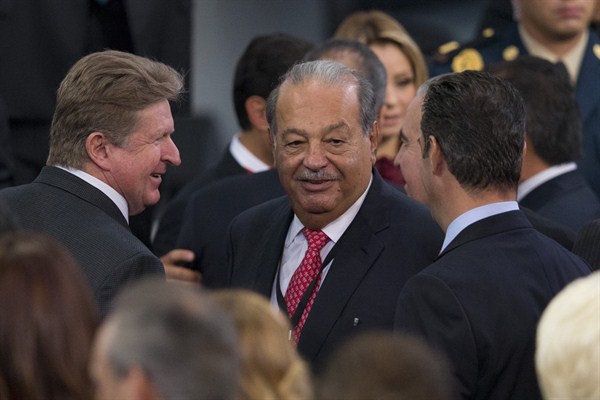Mexico’s cartels are known for their violence and ruthlessness, the control they exert over the drug trade and for Hollywood-esque escapes from so-called high-security prisons. But not much is known or even acknowledged outside the country about another network exerting significant power and doing its own damage to the country: an economic cartel that enjoys market domination in major sectors of the economy, beneficial treatment from the authorities and whose fortunes have skyrocketed at the expense of ordinary Mexicans.
A new bi-annual report by Coneval, a Mexican government agency evaluating social policies, should raise the alarm. It showed that Mexico’s overall poverty rate rose in 2014 to an embarrassingly high 46.2 percent, representing 55.3 million people, up from 44.3 percent in 2008. Nonetheless, from 2008 to 2014, economic growth averaged 1.9 percent, based on figures from the World Bank. The fact that overall poverty is on the rise again not only represents a major failure in Mexico’s economic policy and federal social assistance programs, it also puzzles economists who have repeatedly praised Mexico’s macroeconomic management and openness. Why is poverty growing in a country with sound economic indicators and stable, albeit mediocre, growth? What malfunctions in the Mexican economy prevent it from joining the developed countries’ club? And most importantly, is there a way out of the poverty trap?
Until the 1970s, Mexico was a semi-socialist country, where most industries were state monopolies, and high tariffs were imposed on foreign goods under an import-substitution scheme. But with debt crises in the 1980s and 1990s, a wave of industries were privatized and the economy gradually opened. Government industries were sold to a handful of affluent Mexican families and were soon turned into oligopolies that dominated the market in most sectors of the economy. Although Mexico’s entry into NAFTA in 1994 and the World Trade Organization in 1995 allowed for the entry of more goods and competition, the government shielded and barred competition in key sectors, notably telecommunications and energy. In other sectors, the control of established Mexican companies was, and remains, so outright that national and foreign competitors have struggled to keep their businesses afloat.

